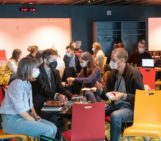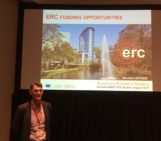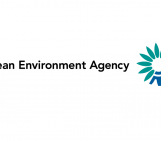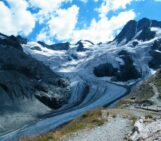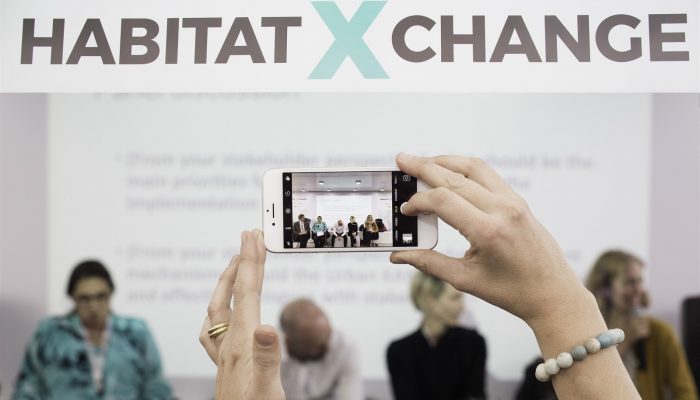
This month’s GeoPolicy is a guest post by the International Council for Science (ICSU). Based in Paris, the organisation works at the science-policy interface on the international scale. Here, Heide Hackmann, Executive Director at ICSU, highlights key initiatives ensuring science is present within the United Nations (UN) and explains how ICSU and the scientific community can support these processes.
The past years were an extraordinary time for the UN, with key international agreements on disaster risk reduction, climate change, sustainable development and urbanization being concluded. The decisions taken in the last two years will shape global policy for decades. It was an exciting time for science, too – getting the Paris Agreement in place, for example, was after all a result of decades (centuries, actually) of research, and of science sounding the alarm on the effects of carbon emissions on the climate. Without the relentless work of the climate science community, the issue of climate change would never have received the political attention it needed, plunging humankind headlong into its dangerous consequences.
The UN policy cycle of the last two years started in 2015 with the Sustainable Development Goals and ended, in October 2016, with the New Urban Agenda, being agreed in Quito, Ecuador. Now is a good time to look back at some aspects of how and why science has been a part of the creation of these UN policy frameworks, and start a conversation about what its role could be in their implementation.
The idea that scientific progress should benefit society has been central to the mission of the International Council for Science (ICSU) since its foundation in 1931. Its membership consists of national scientific bodies (122 members, representing 142 countries), international scientific unions (31 members), as well as 22 associate members. Through its members the Council identifies major issues of importance to science and society and mobilizes scientists to address them. It facilitates interaction amongst scientists across all disciplines and from all countries and promotes the participation of all scientists—regardless of race, citizenship, language, political stance, or gender—in the international scientific endeavour.

The International Council for Science Logo Credit: ICSU
A core part of the Council’s work relates to the provision of scientific input and advice to inform policy development. It has a long history in this arena, having for example in the 1950s catalyzed international climate research through its organization of the International Geophysical Year (IGY). Following the IGY, ICSU encouraged the United Nations to include the climate change issue in policy development processes and in the 1970s convened key meetings that led to the creation of the World Climate Research Programme in 1980 and, eventually, to the Intergovernmental Panel on Climate Change (IPCC) in 1988. In 1992, ICSU was invited to coordinate the inputs of the international scientific community to the United Nations Conference on Environment and Development (UNCED) in Rio de Janeiro and, again in 2002, to the World Summit on Sustainable Development (WSSD) in Johannesburg.
There is no one model of how to make science heard at the UN
All processes at the science-policy interface are different: Sometimes the Council has a formal role representing the scientific community at the UN. In other processes it is just one of many organizations creating pathways for communities of scientists to be heard. In yet other cases, ICSU plays a coordinating role, contributing to the architecture of international science advisory mechanisms and developing the scientific infrastructure underpinning UN policy processes. So each time we decide to engage in a new process, we have a close look at who is doing what in the space, and what the unique contribution of an international science council could be. Here are a couple of examples of what we thought were useful contributions:
In the process leading to the agreement of the Sustainable Development Goals (SDGs), the Council formally represented the international scientific community as part of the Major Group for Science and Technology (together with WFEO and ISSC), a stakeholder structure designed to provide civil society input into the intergovernmental negotiations. This typically involved coordinating written and oral inputs to the meetings of the UN working group involved in their creation to advocate for science-based decision- and policy-making.
The Council also published the only scientific review of the Sustainable Development Goals. Based on the work of more than 40 researchers from a range of fields across the natural and social sciences, it found that of the 169 targets beneath the 17 draft goals, just 29% are well defined and based on the latest scientific evidence, while 54% need more work and 17% are weak or non-essential. On its release, the report received widespread coverage in international media. Right now, the Council is working on finalizing a follow-up report that examines synergies and trade-offs between different goals, drawing attention to the need for mapping and characterising interactions between SDGs to avoid negative outcomes. Expect that report to be published in early 2017.
For the climate change process, the IPCC served as the obvious voice of science. However, as an intergovernmental body, its focus was not so much directed towards public outreach. This left a niche for another contribution by the Council to the UN negotiations. In the 18 months prior to the COP21 climate negotiations in Paris, December 2015, the Council operated the Road to Paris website, a stand-alone media product emerging from the scientific community. The site followed three major international policy processes that concluded in 2015: disaster risk reduction, sustainable development and climate change. Its content was designed to augment the existing media coverage of these processes from a scientific point of view. Just before COP21, a collection of the most read and most shared articles on the website was published in a magazine format. This involvement in the COP21 discussions culminated in the Council’s role at the conference itself, where it provided a focal point for scientists present to gather, network, discuss key scientific challenges and communicate to the media in the last days of the conference on the Paris Agreement.
At Habitat III, the UN’s conference on sustainable urbanization, we tried yet another approach. The stakeholder input for this process was organized in a much more bottom-up way, with no one organization being assigned formal representation of the science community. The input of the research community through what was called the “General Assembly of Partners” had a distinct impact on the outcome document. For example, in March of 2016, there was not a single mention of the word “health” in the draft of that document, yet by the time it was agreed in Quito, 25 mentions of “health” had appeared. Additionally, for Quito we teamed up with Future Earth and the University of Applied Sciences Potsdam to create a space called Habitat X Change. At the previous conferences, we had noticed that scientists were keen for an on-the-ground rallying point – for a physical space where scientists can meet, connect with one another and with stakeholders to exchange ideas, make the voice of science heard, and form new networks to work together in the future. Habitat X Change quickly became a natural focal point for scientists at the conference, providing a space for them to hold events, meet one another, showcase their research, or just have a coffee and talk. See our photos on Flickr to get an impression of how people at the conference filled it with life and meaning.
Overall, we found that there is a big interest in scientific input and opinion at these conferences. For example, at a spontaneously organized climate science press conference during the 2015 climate talks in Paris, more than 200 journalists crammed into the room, beleaguering the scientists with questions long after the conclusion of the press briefing. The voice of science is seen as more neutral and disinterested than those of the many activist groups jostling for attention around these processes.
The big frameworks are all in place – is science still needed now?
With the Paris Agreement in force, the world now has a legally binding agreement to limit dangerous climate change. The Sustainable Development Goals provide a roadmap to a more equitable, sustainable future. The New Urban Agenda tells us what the role of cities in all this will be. What then is the role for science in turning these political documents into realities on the ground?
One thing is to help deal with their complexity. Even before the SDGs were agreed, some started questioning them, saying that success in one goal might offset gains in others, if done the wrong way. Science can help make sense of these interactions and help policymakers avoid pitfalls. Making the New Urban Agenda a success requires efficient ways of linking knowledge production and policy-making, and closely linking the implementation of this Agenda with the SDGs. And the Paris Agreement prominently calls on the scientific community (represented by the IPCC) to identify pathways to limit global warming to 1.5° C. There is a wealth of problems that need solutions from science in order to make these political agreements a success.
The scientific community also needs to help identify and fill critical knowledge gaps. Here, the Council’s research programmes are actively contributing to the implementation of the agreements. For example, the Integrated Research on Disaster Risk (IRDR) programme is helping to define minimum data standards for the indicators for the Sendai Agreement on disaster risk reduction. WCRP is bringing to the fore the remaining gaps in basic research on climate change. Future Earth is building scientific and stakeholder coalitions called Knowledge Action Networks around priority areas for these global agreements.
At the same time, the implementation phase of these frameworks poses challenges because it requires a cultural shift for science as it moves towards being a partner in co-creating the solutions needed by policymakers. It requires building long term frameworks to work at different scales, and importantly at the national level. This has implications for the kinds of organizations that are a central part of the Council’s core constituency: its broad base of national scientific academies. It also means engaging meaningfully with stakeholders to deliver the knowledge that is needed, and staying engaged during the implementation, not just the creation, of these frameworks.
Written by Heide Hackmann, Executive Director at the International Council for Science.

